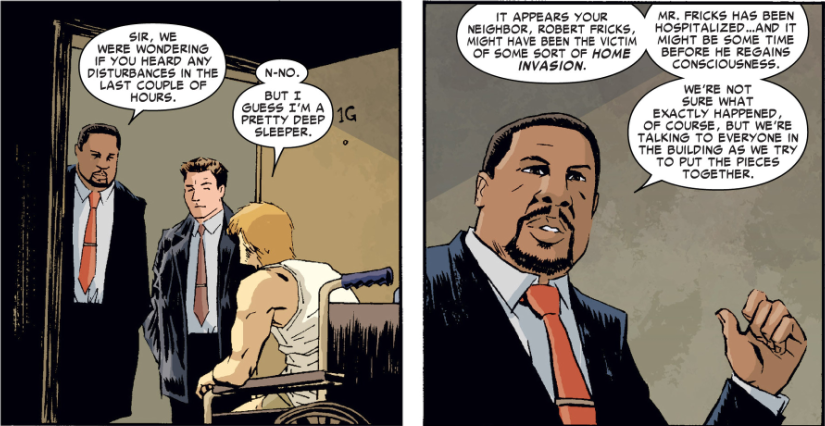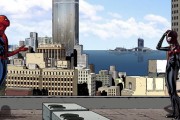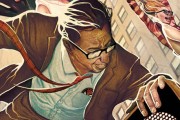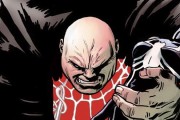I haven’t written all that much about Flash Thompson’s escapades as killer symbiote Venom since Rick Remender left the title last year. It’s not that I haven’t been enjoying Venom – Cullen Bunn is having some fun with the series, though in a much more straight-forward action-adventurey way than Remender’s more meditative approach. But I just haven’t felt compelled to wax poetic much about the series, despite the fact that I know the symbiote-fanatics on social media have been going ga-ga for Eddie Brock’s return as Toxin.
But what actually caught my attention in the latest issue, Venom #31, was the mish-mash of pop culture references littered throughout. The most obvious was the two detectives who visited Flash’s new apartment in Philadelphia, who looked an awful lot like detectives Bunk Moreland and Jimmy McNulty from the HBO cult series “The Wire.” I got a kick out of the reference since earlier this year after some serious urging from my best friend I FINALLY started watching the series in all of its infinite glory (and let me tell any of you who haven’t watched The Wire to seek out a friend who has the DVDs and do the same – don’t do it through Netflix because it’s an addicting show and you won’t be able to wait a few days between discs). After sleuthing around and hitting upon the always reliable Venom Site, I saw that two MORE television pop culture references were worked into the issue: a Walter White “have you seen this man” poster from the almost-as-good-as-the-Wire AMC series, Breaking Bad, and “Nightman,” from FX’s It’s Always Funny in Philadelphia (which is the only series here I really don’t watch, but may actually be the most apropos since Venom actually takes place in the City of Brotherly Love).
That got me thinking about how I read comic books and if these kinds of hidden references – dubbed “Easter Eggs” by some who dedicate regular columns to them – ultimately add or distract from the reading experience. I think in the cases of the Walter White and Always Sunny posters – Easter eggs that are so subtle a reader is actually inclined to overlook them (like I did) if they’re not looking for them, they’re a perfectly acceptable way for the artist to work in some winks and nudges to the crowds (also see John Lennon and Dick Van Dyke finding their way into the church for the wedding of Mister Fantastic and Sue Storm in Marvels #2). But in the case of Bunk and McNulty, I almost feel like the scene grinds the whole comic to a halt – to the point that I’m here spilling a few hundred words about it because it’s the biggest impression the comic book made on me.
I totally appreciate that Venom’s artist, Declan Shalvey has great taste in television and is such a fan of The Wire that he chose to pay homage to Bunk and McNulty in this fashion. The Season 1 scene where the two of them investigate a murder scene by only using a certain four letter word over and over (link NSFW)? Brilliant, brilliant television. But does it warrant a place in a Marvel comic book? Questionable.
Thinking strictly pragmatically, one issue with their inclusion is the fact that The Wire is a show that definitively takes place in Baltimore (though they do travel to Philadelphia in brief snippets). Given that Bunn and Shalvey are going to great lengths to establish a new locale for their comic book series, I would have hesitated bringing in two ringers from another major American East Coast city. Set the comic in Baltimore, and I legitimately don’t have a leg to stand on with this argument.
But the bigger issue is the blurring of these two specific pop culture phenomenons. Part of what makes The Wire such an exceptional show is its attention to detail and its often unsettling realism about police work, the drug trade and the entire mechanics of how a major American city in decline works (or doesn’t work). David Simon and Ed Burns, the creators of the show, have fictionalized everything, but have gone to great lengths to incorporate real life drama from their experiences at the Baltimore Sun newspaper and the Baltimore City Police Department, respectively. While I know the show has been homaged in other instances (including some great inside references from Michael K. Williams on Community), it seems less severe than seeing these two characters in the pages of a comic book.
The Marvel Universe obviously operates using an entirely different set of rules than the world of The Wire’s Baltimore or Community’s Greendale. Marvel/Venom’s world features individuals with abilities that transcend ordinary human capablities, including paraplegics who regain the ability to walk by bonding with an alien symbiote that also has a murderous mind of its own. Apples and oranges, right? It’s one thing to visually homage the mugging/death of Bruce Wayne’s parents in a Spider-Man comic book, because the joke is comic to comic. It’s another to mix and mingle the real world (albeit a fictionalized one) with the comic book world.
And if this comes across as an old and farty way of looking at things, I’m at least consistent. Last year, I said the use of real-world politicians in the “Ends of the Earth” storyline “took me out of the comic” when I read those particular issues. It’s a great visual gag, but perhaps I just prefer my TV/movies/current events/comic books all to be neatly catalogued in their own individual spaces.





